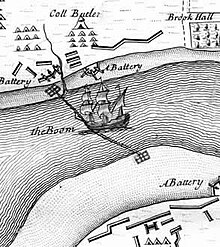
A | B | C | D | E | F | G | H | CH | I | J | K | L | M | N | O | P | Q | R | S | T | U | V | W | X | Y | Z | 0 | 1 | 2 | 3 | 4 | 5 | 6 | 7 | 8 | 9

A boom or a chain (also boom defence, harbour chain, river chain, chain boom, boom chain or variants) is an obstacle strung across a navigable stretch of water to control or block navigation.
In modern times they usually have civil uses, such as to prevent access to a dangerous river channel. But, especially historically, they have been used militarily, with the goal of denying access to an enemy's ships: a modern example is the anti-submarine net.
Booms have also been used to force passing vessels to pay a toll.[1][2]
Description
A boom generally floats on the surface, while a chain can be on the surface or below the water. A chain could be made to float with rafts, logs, ships or other wood, making the chain a boom as well.
Historical uses
Especially in medieval times, the end of a chain could be attached to a chain tower or boom tower. This allowed safe raising or lowering of the chain, as they were often heavily fortified.[1] By raising or lowering a chain or boom, access could be selectively granted rather than simply rendering the stretch of water completely inaccessible. The raising and lowering could be accomplished by a windlass mechanism or a capstan.[3]
Booms or chains could be broken by a sufficiently large or heavy ship, and this occurred on many occasions, including the siege of Damietta, the raid on the Medway and the Battle of Vigo Bay.[4][5][6][7]A Frequently, however, attackers instead seized the defences and cut the chain or boom by more conventional methods. The boom at the siege of Derry, for example, was cut by sailors in a longboat.
As a key portion of defences, booms were usually heavily defended. This involved shore-based chain towers, artillery batteries, or forts. In the Age of Sail, a boom protecting a harbour could have several ships defending it with their broadsides, discouraging assaults on the boom. On some occasions, multiple booms spanned a single stretch of water.
Gallery
-
Crusaders break a chain protecting the harbour (at left) in the siege of Damietta.
-
Boom towers in Norwich
-
Remains of the great chain that protected the Golden Horn
-
A preserved section of the Hudson River Chain
-
Remains of the Shoeburyness Boom, built to protect the Thames Estuary from Soviet submarines during the Cold War
Examples
Historical

- The entrance to the Cothon at Carthage was protected by a chain.
- The chain at Fort Blockhouse, protecting Portsmouth Harbour from 1431 to 1539.
- The Leonine Wall included a chain blocking the Tiber
- A chain spanned the Golden Horn
- A chain and boom blocked the River Medway during the Raid on the Medway
- Hudson River Chain
- The chain blocking the Parana River during the Battle of Vuelta de Obligado
- A chain was placed from Columbus, Kentucky across the Mississippi River to Missouri in order to block Union ships during the American Civil War[8]
- Between the A Palma Castle in Mugardos and Saint Philip Castle, in ria of Ferrol, to defend the city and naval base.
See also
- Anti-submarine net
- Boom defence vessel - a vessel charged with laying anti-submarine nets
- Log boom - a boom for collecting logs
- Boom (containment) - a boom for containing oil spills
Notes
- A.^ Some sources have the chain being dismantled instead of broken by a ship in the siege of Damietta and in the raid on the Medway.
References
- ^ a b Philip Davis (May 7, 2012). "Site types in the Gatehouse listings — Chain Tower". Gatehouse. Retrieved October 17, 2013.
- ^ Boom Towers, Norwich
- ^ Bob Hind (January 27, 2013). "Filling in the missing links on history of harbour chain". The News. Archived from the original on October 21, 2013. Retrieved October 17, 2013.
- ^ Gibbon, Edward. The History of the Decline and Fall of the Roman Empire, Volume 6. p. 510.
- ^ "THE DUTCH IN THE MEDWAY - 1667". M.A. de Ruyter Foundation. Archived from the original on October 21, 2013. Retrieved October 21, 2013.
- ^ Hervey, Frederic (1779). The Naval History of Great Britain: From the Earliest Times to the Rising of the Parliament in 1779. W Adlard. pp. 77.
- ^ Long, WH (2010). Medals of the British Navy and How They Were Won. Great Britain: Lancer Publishers. p. 24. ISBN 9781935501275.
- ^ "The Mississippi River in the Civil War Historical Marker".
Text je dostupný za podmienok Creative Commons Attribution/Share-Alike License 3.0 Unported; prípadne za ďalších podmienok. Podrobnejšie informácie nájdete na stránke Podmienky použitia.
Antropológia
Aplikované vedy
Bibliometria
Dejiny vedy
Encyklopédie
Filozofia vedy
Forenzné vedy
Humanitné vedy
Knižničná veda
Kryogenika
Kryptológia
Kulturológia
Literárna veda
Medzidisciplinárne oblasti
Metódy kvantitatívnej analýzy
Metavedy
Metodika
Text je dostupný za podmienok Creative
Commons Attribution/Share-Alike License 3.0 Unported; prípadne za ďalších
podmienok.
Podrobnejšie informácie nájdete na stránke Podmienky
použitia.
www.astronomia.sk | www.biologia.sk | www.botanika.sk | www.dejiny.sk | www.economy.sk | www.elektrotechnika.sk | www.estetika.sk | www.farmakologia.sk | www.filozofia.sk | Fyzika | www.futurologia.sk | www.genetika.sk | www.chemia.sk | www.lingvistika.sk | www.politologia.sk | www.psychologia.sk | www.sexuologia.sk | www.sociologia.sk | www.veda.sk I www.zoologia.sk





